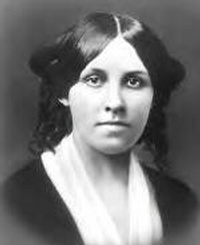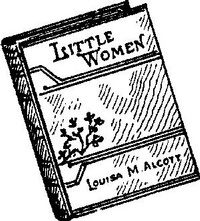
Louisa May Alcott
By John T. Marck
A Look At Her Life, Her Family and
"Little Women"
 
Louisa May Alcott was born in Germantown, Pennsylvania on
November 29, 1832, the second of four daughters of Amos Bronson Alcott and
Abigail May. Her father, Amos was the son of a flax farmer, (plants with blue
flowers whose seeds yield linseed oil, and from which whose stems a
light-colored textile fiber is obtained) who had taught himself to read. He
also was an educator and the leader of the transcendentalists, which was a
term used in New England to describe a crusade of writers and thinkers in the
1830s. It was their belief that all people were born righteous, and that all
possessed the power of intuition, and that through nature they could become
close to God.
Amos Alcott who taught in Connecticut, Pennsylvania and
Massachusetts, believed that all the knowledge and morality that people had
from their inner selves could be brought to the surface in a way that would
benefit society, with the help of a teacher. He was the first to usher in
subjects such as art, music, nature studies, and physical education to his
pupils during a time when these subjects weren't taught. Consequently, many
parents did not understand his methods, and removed their children from his
class. As a result, Amos moved his family more than twenty times in thirty
years. Through the years, he and his family became good friends with Ralph
Waldo Emerson and Henry David Thoreau.
During the years from 1859 to 1864, Amos served as the
superintendent of Schools in Concord. It would be in Concord that his lifelong
dream of starting a School of Philosophy finally became a reality. Designed as
a summer school for adults, his Concord School of Philosophy operated for nine
summers until July 1888. It closed with a memorial service to Amos Alcott who
had died a few months earlier on March 4.
When the Alcott's moved to Concord in 1840, Amos bought two
houses that both dated to the 1700s. The smaller of the two was used as a
tenant house, but eventually Amos moved it to their main house, and adjoined
it to the rear of the house. At this time, the land on which his house stood
consisted of twelve acres of apple orchards, because Amos believed that apples
were the perfect food. With this in mine, his home became known as the
"Orchard House." The Alcott's stayed here between 1858 and 1877.
Amos's wife and the mother of their four daughters, Louisa,
May, Elizabeth and Anna, was Abigail May. She was born on October 8, 1800, and
was the youngest daughter of Colonel Joseph May and Dorothy Sewall. As a
descendent of the famous Quincy and Sewall families in New England, her great
aunt was Dorothy Quincy, the wife of John Hancock, the first governor of
Massachusetts.
Abigail met Amos Alcott in Brooklyn, Connecticut one day
while he was visiting her brother at his home. They engaged in a long
courtship, eventually marrying on May 23, 1830 at King's Chapel in Boston.
Abigail died in November 1877.
After originally moving to Concord in 1840, the Alcott
family took part in an experimental communal village in 1843 known as the
Fruitlands. This experiment was that of Amos, who wanted to use it to further
his transcendental beliefs, while bringing his daughters closer to nature.
However, his experiment failed two years later, and the family moved back to
Concord at an area known as Hillside.
In 1849, while experiencing financial problems, Amos moved
his family to Boston. To help out, Louisa began reading to an elderly man as
his invalid sister, but this paid very little. Louisa then, along with her
sister Anna, began teaching children as well as mended and washed clothes to
help provide for their family. In 1852, Louisa wrote and had published her
first poem titled
"Sunlight," in Peterson's magazine.
However, it was not published under her name, but her anonym, Flora Fairfield.
Although Louisa did not receive a lot of money for it, it would be her start
to a career that eventually would bring her financial success.
Within three years, in 1855, Louisa wrote and had published
her first book titled, " Flower Fables." At this time her
family moved to Walpole, New Hampshire, but Louisa stayed in Boston to further
her career. One year later, in 1856, her sister, Elizabeth, or Beth as
everyone knew her, contracted scarlet fever. Although she recovered for a
time, her illness forced her family to move back to Concord where they stayed
at Orchard House. For two years she suffered with the disease until her death
on March 14, 1858.
With the sickness and subsequent death of Elizabeth, as
well as the wedding of her sister Anna in 1860, Louisa moved back to Concord
in 1857, and as well resided at Orchard House. Here she helped her mother get
over the loss of two of her daughters, one to death, and one to marriage. In 1862, with
the Civil War raging, Louisa felt the need to help out as a nurse. Although
best known as an author, her position as a nurse during the Civil War, brought
her two careers together. It turned out that her first book to be published
during the war, expressed her experiences as a volunteer nurse in Washington,
D.C., at Georgetown's Union Hospital. This book, titled
Hospital Sketches (1863), told of the appalling conditions she encountered
in the hospital, describing the lack of ventilation and sanitary systems,
whereby she labeled the hospital a "perfect pestilence box."
Additionally, she told of the indifference of the doctors
and nurses toward these conditions. During the time that Louisa worked at the
hospital, she wrote letters home describing these conditions, which later
became Hospital Sketches. To combat the horrible smells
from this poor sanitation, she would frequently sprinkle herself and her
surroundings with lavender water. As a result, she was soon called the "Nurse
with the Bottle." Her second book during the war was titled Moods,
published in 1864.
Also in 1864, Louisa's publisher, Thomas Niles of Boston,
asked her if she could write a book for young girls. Accepting the challenge,
Louisa began writing at Orchard House, a story that was based on her own
experiences growing up with her three sisters. In less than three months,
Little Women, her most famous novel, was born. Published on
September 30, 1868, it was an instant success selling more than two thousand
copies as soon as it hit the stores. So successful was Little Women
that her publisher implored her for a second volume, which was published on
April 14, 1869, selling more than thirteen thousand copies.
In Little Women, Louisa traces the lives
and personalities of four sisters, emerging from childhood to adolescents to
marriage, as well as the changes in employment and society. Her portrayal of a
wholesome family life was one in which young readers of the day could
identify. She chose the following names for her mother and sisters in
"Little Women." Her mother, Abigail is Marmee; her older sister Anna is Meg,
and the description of Meg's wedding in this book is actually as it really
happened when Anna married John Bridge Pratt in the parlor of Orchard House on
May 23, 1860; Louisa portrayed herself as Jo; Elizabeth, the third born is
Beth, and her youngest sister May is Amy.
Following the success of
"Little Women,"
Louisa was able to paid off her debts and become financially independent. Her
next book published in 1870 was "Old Fashioned Girl."
Louisa's success grew and grew, and she enjoyed a huge
following of young readers. She then wrote and had published " Little
Men" in 1871. Her next books were "Work" in 1871; "Eight Cousins"
in 1874; and "Rose in Bloom" in 1876. Also during this time, Louisa
became involved in the women's suffrage movement, and wrote for the Woman's
Journal, sending messages in an attempt to get woman to vote. In 1879
Louisa became the first woman in Concord to register to vote.
In 1878, her sister May married a Swiss businessman, and
they settled in Meudon, France, a suburb of Paris. In November 1879, May gave
birth to a daughter, named Louisa May, who was nicknamed "Lulu." Tragically,
May died on December 29, six weeks after her daughter was born. On May's
request, Lulu was sent to Louisa in Concord in 1880. Louisa's remaining
sister, Anna, had two sons Frederick and John. Sadly, her husband died in
1877, so with Louisa's help, Anna bought the Thoreau House in Concord and she
spent the last years of her life here.
Now caring for Lulu, and her father, Louisa moved to an
elegant house at Louisburg Square in Boston. Early in her life, while a nurse
during the Civil War, Louisa had contracted typhoid fever, and although
recovered, suffered the lasting effects of mercury poisoning. At the time,
doctors used calomel, which was a drug laden with mercury to cure typhoid.
With the poisoning beginning to take its effect, Louisa still managed to write
her final novel titled Jo's Boys, which was published in
1886.
As her father died on March 4, 1888, sadly, Louisa died
only two days later on March 6, in Boston, Massachusetts, at the young age of
fifty-six.
Louisa May Alcott was a great lady, and a gifted author who
left a heritage in her wonderful books that have been and will remain to be
treasured and adored for generations.
Copyright ©1993-2022 by John T. Marck. All Rights Reserved. This article and their
accompanying pictures, photographs, and line art, may not be resold,
reprinted, or redistributed for compensation of any kind without prior written
permission from the author.
|

